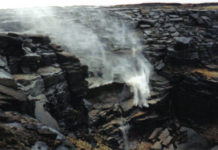The beauty and the romance which encircles the surroundings of the Castlerigg stone circle is known to many. If Stonehenge is the most famous stone circle in Britain, the Castlerigg Stone Circle, near Keswick in the Lake District, must be the most atmospheric. It is considered as one of the most visually impressive prehistoric monuments in Britain.
Situated in an open bowl between rolling hills, this Megalithic construction appears as a perfect picture postcard. This is the land of Wordsworth, Coleridge and Romantic poetry; but many millennia before, it was home to an equally creative race.
The Castlerigg Stone Circle, also known as Keswick Carle or Druid’s Circle, is one of the oldest in Britain. It was built in around 3,000 BC and comprises 40 stones of various heights placed in a slightly oval shape. The largest stone is over 8 feet tall, but the majority of them are less than 5 feet high.
However, there are many who believe in the tradition that it is impossible to count the number of stones inside Castlerigg: implying that every attempt would result in a different answer. This could be quite a possibility if the numerous smaller sized stones are taken into consideration. These small stones could possibly have been placed to support the bigger stones and have propped up due to erosion. One of the main causes of erosion is the high number of visitors coming to visit the site.
Although five of the stones have collapsed, it is a site in remarkably good condition. It has a feature unique among stone circles in Britain. Inside the ring of rocks, ten smaller stones are placed in a rectangle in an arrangement called ‘The Cave’. There is also a slight mound in the centre, which, it has been suggested, is a burial chamber.
a local legend says the stones were actually men turned to rock by fear of a local monster.
However, the site has never been properly excavated, and perfunctory archaeological studies have only ever uncovered charcoal deposits. Like Stonehenge, the site has qualities which make it suitable for use as an astronomical observatory, although an unpolished stone blade found near the circle suggests it may have been used as a centre of trade for the area’s Neolithic axe industry.
There is also a local legend that says the stones were never built to any design but were actually men turned to rock by fear of a local monster. In all likelihood, it probably formed a focal point for the local community, and may have been used for a combination of commercial, religious and tribal purposes. For now, we can only admire the stunning sight of this early man-made structure placed in an area of unique natural beauty.
Archaeological sites such as these are treasures which should be preserved for our coming generations. Not only they give us some crucial knowledge of our past ancestors but also add to the heritage of human existence.
-end-




































